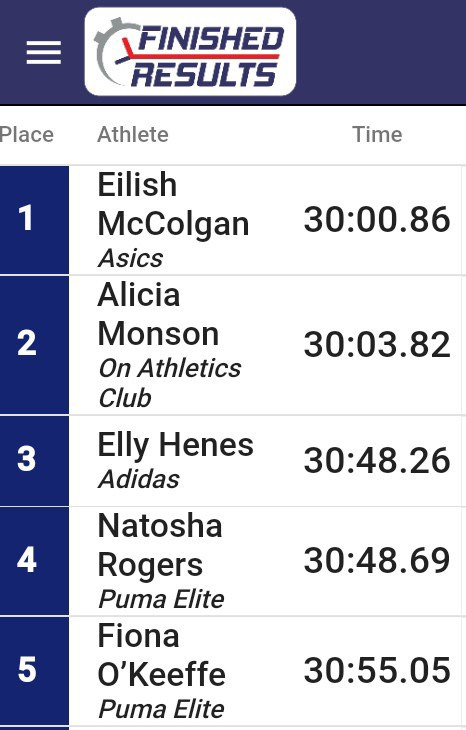Alicia Monson's 30:03.86 makes as much sense as anything
The U.S. greats of the 1990s may as well have been running in a different century
On July 8, 1996, in Stockholm, Sweden, a 22-year-old Providence College graduate named Amy Rudolph ran 14:56.04 for 5,000 meters to shave three-hundredths of a second from Annette Hand-Peters’ three-year-old American record. Rudolph, now coaching at Iowa State University, would place tenth in the Olympic Games in that event that summer in Atlanta.
Rudolph also made the U.S. Olympic Team in 2000, but in Sydney was weakened by a flu-like illness. Curiously, an outbreak of this malady in the Olympic Village did not lead Australian officials to cancel the Games and throw everyone out of the country, but it did contribute to Rudolph finishing 21st in her preliminary heat.
In May 2005, Rudolph ran 31:18.96 for 10,000 meters in her debut at the distance, then the second-fastest American mark ever and nearly nine years after she set the 5,000-meter American record. Rudolph remains one of the greatest American distance runners of all time; well- crafted tributes in hometown newspapers always play well, and this one out of small-town Pennsylvania nicely sums up Rudolph's athletic career.
Two years after Rudolph ran 14:56.04, Regina Jacobs dragged the U.S. 5,000-meter record down to 14:52.49. Then, in July 2000, Jacobs celebrated the new millennium by shattering her own mark with a 14:45.35 at the Olympic Trials in Sacramento, California. In 2003, still running 4:03 for 1,500 meters at age 39, Jacobs was suspended for testing positive for the banned designer steroid THG and retired.
14:56 is a time worth recalling because last night, Alicia Monson split around 15:08.8/14:55 in breaking Molly Huddle’s 2016 American 10,000-meter record by over nine seconds with a 30:03.86 (meet results). In leading the race from 5,000 meters until the final lap, when Eilish McColgan loped away from her, Monson ran faster over the final twelve and a half laps than all but approximately seventeen American women have ever run for an open 5,000 meters outdoors (Kara Goucher’s 14:55.02 makes her 18th all-time).
Last year at this event, where Elise Cranny narrowly missed Huddle’s record, the organizers used pacing lights. This year, whether it was the athletes’ decision or the organizers’, there were no lights. The women in the race—appropriately saved for last among the nine featured contests—provided their own glow, as Monson moved from number seven to number one on the all-time American list and three new names entered the all-time top ten: 25-lap debutante Elly Henes is now seventh, Natosha Rogers ascended to eighth, and Fiona O’Keefe, also a newcomer at the distance, sits in tenth. (Here’s what the list looked like before last night’s blitz.)
The equivalent of this feat on the men’s side, where the American record is Grant Fisher’s 26:33.84, would look something like a 26:25 with splits of 13:15/13:00 13:20/13:05. When Fisher set that mark a year ago at The Ten, his splits were proportionally similar to Monson’s (13:23/13:10) and he broke the American record by a similarly large amount (around 11 seconds). But a second half of 13:10 isn’t good enough to land in the top twenty on the all-time U.S. 5,000-meter list, although it’s fairly close; that would require closer to 13:05.
The way national and occasionally world records are being broken—by huge amounts and with considerable margins of pacing error—is a new thing, and seems difficult to pin in any way on the current generation of racing shoes that revamped track at every level between around 2019 and 2021. Somehow, more athletes are finding ways to express heretofore unexpressed levels of competitive fitness. It could be as simple as more frequent racing opportunities. It could be better overall attention to personal health habits like sleep and self-care overtures avoiding too much Internet time. Perhaps multiple coaches became renegades and geniuses at the same time. And maybe I typed this entire paragraph with a straight face.
I will defer reviewing in detail the other races at the Sound Running meet mainly because my computer touchpad is malfunctioning and I have a remarkably low tolerance for dancing cursors and randomly opening and closing browser tabs, and in all seriousness, I shouldn'teven own a computer and regularly consider ditching all of my devices entirely for my own good. I would be much happier if I were limited to 1980s technology, even and especially if this meant being unable to participate in today's version of everyday life. I imagine losing everything necessary to allegedly function, yet gaining even more from within a screenless and tranquil—if completely indolent—mode of permanent isolation from worldly happenings.
But this is also because the women’s 10,000 meters was by far the major story of the night. Still, in the men’s 1,500 meters, Leo Young of Newbury Park High School in California ran 3:40.86 to move into sixth on the U.S. all-time high-school list and second among current Newbury Park runners; his time converts to a 3:58.52 mile. And the men’s 10,000 meters was a fantastic contest between Woody Kincaid and Joe Klecker, even if Kincaid’s winning time of 27:06.37 (attained in splits of 13:37 and 13:29) was “disappointing.”


